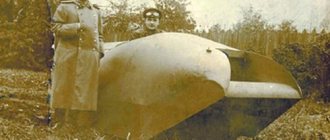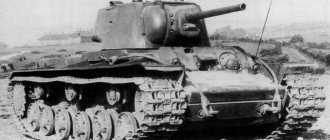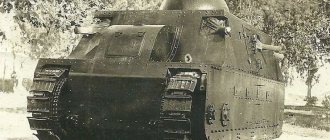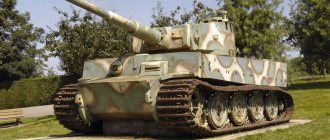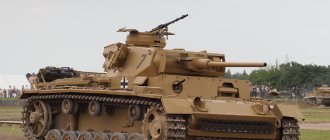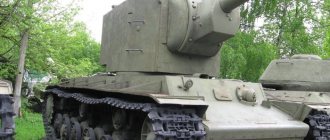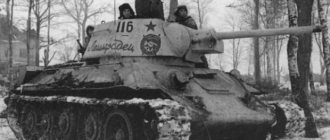Home » Alternative tank building » Post-war tanks of the Third Reich
Editor's Choice Alternative Tank Building
boroda 03/17/2021 3116
13
in Favoritesin Favoritesfrom Favorites 5
The theme of the victorious Third Reich is one of the most popular in alternative history. Just look at such masterpieces as The Man in the High Castle and the like. Therefore, the topic of post-war armored vehicles of the Reich is also no less popular.
Quite recently, I re-posted an old article from our website , which presented the vision of this topic of our Western colleague 1Wyrmshadow1.
In the same article I will present how post-war German tanks are viewed by the company Modelcollect Hobby Inc., which specializes in the production of plastic models of AI vehicles.
The first post-war tanks
During the war, the British began to design a universal tank, later called the “Centurion”. Introducing all the best that was in different types of tanks, it was constantly modernized. The Centurion was produced from 1947 to 1962. The Americans improved their M-26 Pershing heavy tank, which appeared at the end of the war. By improving the chassis, changing the shape of the hull and turret, strengthening the armament and power of the power plant, they brought this design to perfection. This is how the M-60 Patton tank turned out, equipped with a 105 mm cannon and protected by 120 mm armor in the frontal part of the hull and 175 mm in the turret. Created in 1960, the M-60 is still in service with a number of countries.
The Centurion's armament was strengthened: the gun caliber was increased from 76 to 105 mm
The American M-60 Patton tank was built in the 60s. XX century
The most famous post-war tank was the Soviet T-54 . Thanks to the improved diesel engine, installed transversely rather than longitudinally in the tank hull, it was possible to shorten the engine compartment and make the hull lower. These works were carried out at the end of the war on the T-44. Reducing the size of the tank and improving the chassis made it possible to increase the thickness of the frontal armor to 100 mm! The tower gradually changed. On the T-54 it became hemispherical, and the thickness in the frontal part reached 200 mm! The T-54 also received a 100 mm cannon.
Following the T-54, the USSR created the T-55 with a more powerful engine, increased ammunition, an automatic fire extinguishing system and equipped with night vision devices. The last tank of this family was the T-62 , armed with a smooth-bore 115-mm cannon, which made it possible to fire feathered armor-piercing shells flying out of the barrel with enormous speed. The direct shot range of the T-62 was 4 km.
A special feature of the T-55 was its anti-nuclear protection system
Soviet tanks at war
Photo: press service of the Central Military District
With the beginning of the World War, tank forces began to rearm - a whole line of vehicles was developed to replace the old ones: T-35 - KV, T-28 - T-34, BT - A-20, T-26 - T-50, T-37A / T -38 – T-40. The problem was that to replace the huge arsenal of old tanks, an equally huge arsenal of new tanks was required, and it could not be produced quickly. It was also due to the extreme unreliability of engines and running new cars, as well as an organizational mess - when old models are no longer produced, as are their components, and production of new ones has not yet begun. More precisely, it has started, but only a teaspoon per hour.
But all this was decided, something else was not decided - a look at the use of tanks, which was seen in the style of the attack of the Yakovlev brigade at Khalkhin Gol, in numerous and dense masses. This is what the new mechanized corps were designed for - little motorized infantry, little low-speed artillery, weak air defense, but more than a thousand tanks. And in such conditions, our vehicles could be ideal, the tankers heroic to the point of madness. However. Even if the quantity was ten times greater, this advantage was offset by order. And the Germans had order not only in battle - their repair and evacuation service was beyond praise, but with us...
At war
Actually, the beginning of the war proved this - Khatskilevich’s corps (the strongest mechanized corps of ZOVO) was sent on the offensive without air defense, without knowledge of the situation and without air force support.
And what sense is there in the masses of the new KV and T-34, and the old BT and T-26? This was the case everywhere - both in the counterattack of four mechanized corps on Brody on the Southwestern front, and in the crazy counterattacks on the Northwestern front. In this sense, the slogan of the commanders of the Red Army could be the English “the king has a lot.” Tanks were burned in attacks, abandoned with minor damage right on the roads, tanks attacked not only without air defense, but often without infantry. And vice versa, the combined arms commanders pulled apart the tank divisions wherever they could - the tanks assembled in the divisions could not provide support to the infantry, but it was needed. By the end of summer, sobering began to set in - equipment began to run out, and industry was physically unable to make up for the colossal losses. And the middle echelon of commanders who survived the border battle began to think.
“The 4th Tank Brigade carried out brave and skillful military operations since 10/04/1941. to 10/11/1941., despite the significant numerical superiority of the enemy, inflicted heavy losses on him and fulfilled the tasks assigned to the brigade to cover the concentration of our troops... As a result of fierce battles of the brigade with the 3rd and 4th tank divisions and the enemy motorized division, the Nazis lost 133 tanks , 49 guns, 8 aircraft, 15 tractors with ammunition, up to an infantry regiment, 6 mortars and other weapons. The losses of the 4th Tank Brigade are counted in single units.”
And to think intelligently, as soon as one got rid of theoretical illusions and pre-war practice, Comrade Katukov destroyed a German tank division with a small brigade, something that the mechanized corps had not been able to do just a couple of months earlier. The General Staff also thought: divisions of 350 tanks were first reduced to 150-200, and then even to brigades, with fewer tanks than in the pre-war regiment. But they added motorized infantry, mobile artillery, reconnaissance... They also stopped the pursuit of record-breaking vehicles, although this happened largely by accident. The war ate up cars, they needed a lot of them and relatively reliable ones, and the T-34 became such a car - in all modifications the tank was unpretentious and massive - 65,800 units, the most massive series in the history of tanks throughout the world.
They produced other things, of course, KVs, light T-60/70s and heavy ISs, but it was the T-34s that won the war. An interesting point: in 1941, the Germans were inferior to us in the quality of equipment, but they were head and shoulders above us in organization and won. By the end of the war, we were superior to them in organization, but inferior in quality - and we took Berlin. What is important is not technology, but organization, which we, however, quickly forgot about, and as soon as the salvos died down, we began to prepare for the second edition of the Patriotic War.
Tank ocean
Even experts argue about how many tanks we built during the Cold War, or more precisely, what counts as tanks, what was ours, and what was our “allies” in the ATS?
If by type, we get the following: IS-2 - 1140 in 1945 IS-3 - 2315 IS-4 - 258 T-10 - 1593 T-44 vehicles - 1823 T-54 - 16,675 T-55 - 13,287 T -62 - about 20 thousand T-64 - 1192 T-64A - 3997 in service as of 1990 T-72 - about 30 thousand T-80 - about 5000 in service as of 1990 PT-76 - 3039
As a result, we not only had a lot of tanks, like in the pre-war period, but a lot of them. It’s clear that something was written off, something was distributed to allies around the world, something was simply lost in the army’s way, but still by 1990 we had a real ocean of tanks. In fact, our generals and marshals took into account all the mistakes of World War II and prepared a full set of tanks for both line units, and another one for mobilized units. Air defense systems, self-propelled guns, light armored vehicles, and, in general, everything necessary for a war with the whole world combined were developed for tanks. Only little things were not taken into account - a repeat of World War II was not planned, and nuclear weapons completely changed strategy and tactics. And not only that - specifically, tanks had a new enemy at the end of the Great Patriotic War - hand-held anti-tank rocket weapons, light and compact, which only developed later. And later ATGMs, attack aircraft and helicopters, new types of mines, and even later - attack and reconnaissance UAVs. As a result, the massive use of tanks against a serious enemy became difficult, as wars proved time after time, but the love for tanks (in cyclopean quantities) among Soviet generals did not go away.
It did not go away even after the collapse of the USSR. Thus, poor Ukraine deeply and expensively modernized the T-64 to Bulat. In the end:
“The T-64BM Bulat tanks, due to their heavy weight and weak engine, turned out to be ineffective, were transferred to reserve, and replaced by linear T-64s.”
However, the T-64A also performed quite well, even according to Ukrainian official data, 519 tanks were damaged in the Donbass and 79 were completely destroyed. To understand, something that was dragged from the battlefield is considered damaged; what happened to it next is a big question, maybe , and into the oven and onto the needles. And this despite the fact that the opponents of the mechanized army were “partisans” with hand weapons, supported by a small number of volunteers with combat experience. Since 2015, tanks have been used in a positional front in a unique way - as mobile firing points, some kind of ersatz self-propelled guns.
Other wars showed, in principle, the same thing - without air supremacy, without numerous and well-trained infantry, a modern tank is a crypt for the crew, armor is no longer a panacea, and weapons of destruction have stepped very far forward. And the role begins to play not mass, but quality. But what's new in this? In principle, the same Second World War, only at a different technical level, the organization beats the number.
Hence the question: does the modern Russian Federation need a mass of tanks? Or should it be less, but better, and use the remaining funds to train motorized riflemen, anti-aircraft gunners, electronic warfare, and UAVs? Tanks are our symbol, they are the best in the world, but in 1941 they did not bring benefits in accordance with the funds invested, and in 1991 they became one of the factors in the death of the country, due to their numbers and high cost. It’s not for nothing that the Ministry of Defense is in no hurry with Armata, rearmament is money, colossal money, and a breakthrough of tank armies to the English Channel is somehow not expected, and it has been impossible since Hiroshima and Nagasaki. Times are changing, and we also need to understand this and keep up with them.
"Thirty-four" of the XXI century
The legendary "thirty-four" from the Great Patriotic War was not the most powerful, not the fastest, not the most protected tank in the world. However, everything in this tank was so balanced that in terms of its range of combat properties, the T-34 was an order of magnitude superior to all other tanks in the world. The same tank in the last quarter of the twentieth century. the Soviet T-72 . If you put the T-34, T-44, T-54, T-62 and T-72 in one row, you can trace the development of domestic combat vehicles. It seems that this is one and the same tank, which over the decades of its life has “lost its shoulders” and pressed itself to the ground, becoming less noticeable on the battlefield. However, the T-72 is a revolutionary tank. It differs from its predecessors in the same way that the T-34 at one time differed from the BT.
By the end of the twentieth century. The T-72, one of the most popular tanks in the world, has been adopted by more than 20 countries
The T-72 used a new combined three-layer armor (steel - fiberglass - steel). In this regard, the term “effective armor thickness” was introduced (the thickness of the armor in terms of conventional armor steel). For example, the T-72 has an effective turret armor thickness of 50 0 mm. This is equivalent to half a meter thick steel armor. To protect against cumulative shells, the tank was covered with anti-cumulative screens and hinged dynamic protection, which consisted of flat boxes with explosives laid on top of the armor. Having touched the box, the anti-tank missile was destroyed by a directed explosion. The firepower of the T-72 has increased. A 125 mm smoothbore gun was installed on it.
In the mid-1970s. it was the most powerful tank gun in the world. The T-72 could fire finned projectiles and guided missiles. The main highlight is the fire control system and automatic gun loader. The projectile was fed into the barrel and the cartridge case was ejected without human intervention. The T-72 has increased smoothness and speed of movement due to a new chassis with additional rollers supporting the track. The maximum speed was 60 km/h.
The emergence of new offensive and defensive systems expanded the combat capabilities of tanks. This is how the T-90 appeared with a complex of optical-electronic countermeasures against enemy anti-tank weapons. Infrared searchlights help suppress enemy guided missile guidance systems. The protection system warns the crew about laser irradiation. It ensures the release of a device from a special grenade launcher that creates an aerosol cloud impenetrable to laser beams. This disrupts the targeting of laser-guided missiles.
The security of the T-90S has been increased due to the built-in dynamic protection of a new generation
The Russian T-80 tank, unlike the diesel T-72 and T-90, is equipped with a more powerful gas turbine engine, which increases its dynamics and provides a maximum speed of up to 70 km/h - an outstanding value for a combat vehicle weighing 46 tons.
T-80U is the world's first tank with built-in (instead of mounted) dynamic protection. In Chechnya, a case was recorded when the “eighty” withstood eight hits from an RPG in battle
To replace outdated tanks, the T-54 tank, which was developed during the war years, was put into service in 1946 [378, p. 14]. Along with the release of new models, in the first post-war years the production of T-34-85, T-44, IS-3 tanks and SU-100 self-propelled guns continued. Subsequently, at industrial plants and tank repair plants of the Ministry of Defense, measures were taken to modernize the T-34-85, T-44, IS-2, IS-3 (T-44M, IS-2M, IS-ZM) tanks and self-propelled artillery units SU-76M, SU-100 and ISU-152 (ISU-152M, ISU-152K) [376, p.43-46].
By the summer of 1947, the Soviet Army still had 163 Mk-III Valentine tanks, 8 Mk-II Matilda and Mk-IV Churchill tanks, and 2,353 snowmobiles [351, pp. 159-160].
As of October 1, 1947, the armored and mechanized forces of the USSR Armed Forces had 2,315 T-34-76 tanks, including: 1,459 serviceable, 176 requiring medium repairs, 638 major repairs and 42 subject to write-off. During major repairs at the factories of the Ministry of Defense, some T-34-76 tanks (and subsequently T-34-85) were converted into T-34-T tank tractors and SP K-5 and KT-15 cranes [379, p. 43, 45].
In December 1947, acting Commander of the BTMV, Marshal of the Armored Forces Bogdanov, addressed the Minister of the Armed Forces of the USSR with a proposal to change the order of manning tanks and self-propelled guns and, accordingly, the staffing of self-propelled tank regiments in tank mechanized and rifle divisions and self-propelled tank battalions in rifle brigades due to the lack of medium tanks and self-propelled guns in the BTMV and the excess of heavy and light ones Self-propelled guns [351, p. 202-203]. As a result, we switched from different types of equipment to the same type:
- heavy tank self-propelled regiment of a tank division (23 in total) - there were 2 battalions of IS-2 or IS-3 tanks (46 units) and a battalion of SU-100 self-propelled guns (21 units), instead of which the ISU-122 battalion was included (21 units .);
– a heavy self-propelled tank regiment of a mechanized division (47 in total) – there was a battalion of IS-2 or IS-3 tanks (24 units) and 2 battalions of SU-100 self-propelled guns (42 units) – the regiment became one staff with the tank division regiment;
- self-propelled tank regiment of the rifle division (58 in total) - there were 2 battalions of T-34-85 tanks (52 units), as well as a battalion of SU-100 self-propelled guns (16 units), instead of which, with rare exceptions, there were SU- 76 – it was precisely due to the removal of the SU-100 from the BTMV divisions that the rifle divisions were to be equipped;
- a self-propelled tank regiment of a separate rifle brigade (51 in total) - remained in its composition (according to the staff there were 15 T-34-85 and 7 SU-100 - in fact there were SU-76).
It should be noted that if in 1947-1949. The production of tanks was insignificant, but from 1950 onwards it only increased, which made it possible in the 1950s. almost completely equip the Ground Forces divisions with armored vehicles ( Table 5.4
).
Table 5.4
Production of tanks in the USSR in 1946-1955.
| Year | Tanks and self-propelled guns by type | Total | ||||||
| IS-3 | IS-4 | T-10 | T-34-85 | T-44 | T-54 | PT-76 | ||
| 1946 | 830 | — | — | 2701 | 718 | — | — | 4019 |
| 1947 | 600 | 52 | — | — | 200 | 22 | — | 264 |
| 1948 | — | 10 | — | — | — | 593 | — | 748 |
| 1949 | — | 155 | — | — | — | 152 | — | 164 |
| 1950 | — | 12 | — | — | — | 1007 | — | 1032 |
| 1951 | — | 25 | — | — | — | 1566 | 10 | 1576 |
| 1952 | — | — | — | — | — | 1854 | 58 | 1912 |
| 1953 | — | — | 10 | — | — | 2000 | 210 | 2220 |
| 1954 | — | — | 30 | — | — | 2276 | 400 | 2706 |
| 1955 | — | — | 90 | — | — | 2665 | 500 | 3255 |
In addition, the production of self-propelled guns did not stop, although in small quantities - for example, in 1947, 50 ISU-152 and 194 SU-100 were produced.
Production of armored vehicles in the early post-war years and until the 1960s. was carried out at practically the same enterprises as during the war, but in much smaller volumes and often along with national economic equipment. In addition to national economic products, in the first post-war period serial armored vehicles were produced:
– plant No. 75 (since March 1957 – production association Kharkov Transport Engineering Plant named after V.A. Malyshev) in Kharkov – medium tanks T-44, T-54, T-54A, T-54B, T-55, flamethrower tanks TO-54 and TO-55, tank bridge laying machine MTU-12;
– plant No. 183 (since 1945 – Ural Tank Plant named after I.V. Stalin, since September 1963 – Ural Carriage Works) in Nizhny Tagil – medium tanks T-34-85, T-54, T-54A , T-54B, T-55, T-62, armored tractor BTS-2, tank bridge layer MT-55;
– plant No. 174 (transport engineering plant named after the October Revolution) in Omsk – medium tanks T-34-85, T-54, T-54A, T-54B, T-55, T-55A, flamethrower tanks TO-54 and TO-55, self-propelled gun SU-100 (based on the T-34-85 tank), self-propelled gun SU-122 (based on the T-54 tank), self-propelled anti-aircraft gun ZSU-57-2 and bridge layer MTU-20;
– Chelyabinsk Kirov Plant (from June 20, 1958 – Chelyabinsk Tractor Plant (ChTZ), from May 1968 – ChTZ named after V.I. Lenin) – heavy tanks IS-3, IS-4, T-10, T -10A, T-10B, T-10M;
– Leningrad Kirov Plant – T-10M heavy tanks (until January 1964), self-propelled missile launchers;
– Stalingrad Tractor Plant named after. F.E. Dzerzhinsky (since 1961 - Volgograd Tractor Plant) - light tanks PT-76, PT-76B, self-propelled chassis of the Luna missile system, tracked armored personnel carriers BTR-50P, BTR-50PK, command post vehicle BTR-50PU;
– plant No. 40 (from September 26, 1948 – Mytishchi Machine-Building Plant) – ZSU-23-4 self-propelled anti-aircraft installation of the Shilka anti-aircraft artillery complex, ASU-57 airborne self-propelled installation, SU-85 self-propelled artillery installation, artillery observation post APNP-1 and AT-P artillery tractor;
Main battle tank
At the end of the twentieth century. in the armies of the leading countries of the world, the functions of medium and heavy tanks began to be performed by a single or main battle tank (MBT ). All single tanks carry powerful weapons, including a rifled or smooth-bore 120- or 125-mm gun, and have multi-layer ballistic armor, reinforced with built-in or mounted dynamic protection. A special feature of the MBT is its improved power plant: the engine and automatic transmission are made as a single unit, which allows you to change it in 30 minutes. Modern tanks are able to “survive” even under conditions of the use of chemical and nuclear weapons.
In Russia, the main battle tanks are the T-72, T-80 and T-90, which have already been discussed. Our combat vehicles are distinguished by their small size, their weight does not exceed 46-47 tons, so they are highly maneuverable and unnoticeable on the ground. The powerful armament of Russian tanks influenced the development of foreign single tanks. The Germans put a lot of effort into making the turret of the Leopard 2 tank impenetrable to 125 mm shells. As a result, the Leopard-2 turned out to be much heavier than the Russian ones. The same can be said about the English Challenger tank. Leclerc single tank turned out to be a little lighter It weighs about 55 tons. Its main feature is the saturation of electronic devices and digital computing devices that can help the crew be the first to see and hit the enemy.
The combat weight of the German Leopard tank reaches 62 tons
"Leopard-2" of early modifications (pictured) was made in the typical "tiger" traditions of Germany. But time has inexorably erased its distinctive features. With the streamlined shapes of the latest modifications, the tank today is almost impossible to distinguish from other vehicles
Japanese Type-90 - a kind of “leopard” of Asian origin
The French Leclerc tank is called an electronic miracle
The main American tank M-1 Abrams is one of the most advanced single tanks in the world. This is the only one of all foreign tanks that is equipped with a gas turbine power plant. To increase the armor resistance of the frontal parts of the hull and turret of tanks, panels made of depleted uranium began to be included in their multilayer armor. The British, Germans, French and Americans equipped their heavy tanks with powerful 1200-1500- horsepower power plants to increase the speed of movement and the necessary maneuverability.
Neither noisy advertising, nor modern bells and whistles, nor armor using depleted uranium saved the American Abrams from Soviet RPG fire in Iraq.
The South Korean Type-88 is a smaller Abrams, due to the small stature of the Koreans, which, thanks to the hydropneumatic suspension of the first two wheels, can “squat”
Today the English Challenger is one of the heaviest tanks in the world
The tank "Ozorno" is named after the national hero of Brazil
Today, many countries not only equip their armies with a single main tank, but also modernize medium tanks to the level of MBTs, installing advanced fire control systems, increasing their firepower, enhancing armor protection, and increasing the power of the power plant.
National interests
Sweden's small army has few tanks. In addition, special tanks are needed here, given that it is impossible to organize a continuous line of defense on the long coast of Sweden. Swedish engineers have developed an unusual coastal defense tank. Assuming that the enemy should attack from only one direction (from the sea), they decided not to install a rotating turret on the tank. This reduced its height. Three machine guns, a cannon and a gun automatic reloader were rigidly installed in the hull, which increased the rate of fire to 15 rounds per minute!
One of the most unusual tanks, Strv-103 , also turned out to be the lowest tank in the world. All projectiles ricochet off its high-angle frontal armor. Both the commander and the driver can control the weapon. The radio operator sits facing backwards. At the moment of danger, he controls the tank, moving it in reverse from the firing position. Currently, this unusual tank has been withdrawn from service because it cannot fire on the move.
In the Strv-103 tank, aiming the weapon at the target is carried out by changing the position in space of the chassis
The Israeli army needed a different tank, which had to fight both the regular armies of neighboring states and the Palestinian rebels. During the “restoring order”, it was the tanks that had to turn into strongholds. In such situations, high speed, maneuverability and a large range are not needed. At the border, the tanks stood motionless most of the time, with their noses turned towards the potential enemy. Israeli soldiers did not need a tank, but a well-protected steel house, around which the life of a mobile patrol or checkpoint usually took place. That is why Israel created the unusual Merkava (translated from Hebrew as “chariot”). Based on the specific characteristics of Israel, the tank chassis was adapted for mountainous desert conditions.
The Merkava tank is armed with a 105- or 120-mm cannon, three machine guns and a 60-mm mortar
When creating the Merkava, the security of the crew and infantrymen was put at the forefront (the tank has a compartment for 10 paratroopers!). The requirement to preserve the lives of the crew arose for the reason that every soldier of this small country, especially a well-trained tankman, counts. The Merkava received multi-layer armor, and the armor plates of the hull and turret at the front were installed at a large angle. On the latest modifications of the tank, additional armor modules can be installed on top of the main armor. The engine is installed at the front, which became an additional barrier in the path of armor-piercing shells. In the vacated aft part there is a spacious “change house”, which can turn into a casemate for ammunition or into an infirmary.
Today the Merkava is one of the heaviest tanks in the world. Its weight exceeds 60 tons. The Merkava also stands out for its large size. This is the price to pay for high security and the presence of a “habitable” compartment.
Pz.Kpfw.VI King Tiger (Royal Tiger)
Well, the last one in our review is the very real Royal Tiger , but it underwent modernization, either in 1946 or 1947.
I think this car has a backstory like this. After the war, a large number of Royal Tigers remained in service with the Panzerwaffe, and instead of sending them to be melted down, the zealous Germans decided to carry out a deep modernization of them. Its essence was that the vehicles received completely new turrets with new weapons. The authors of the models, of course, do not indicate which gun was installed on the tanks. But in appearance, it seems to me that it has a caliber of no more than 88 mm.
